Daniel Toyama
Not All LLM Reasoners Are Created Equal
Oct 02, 2024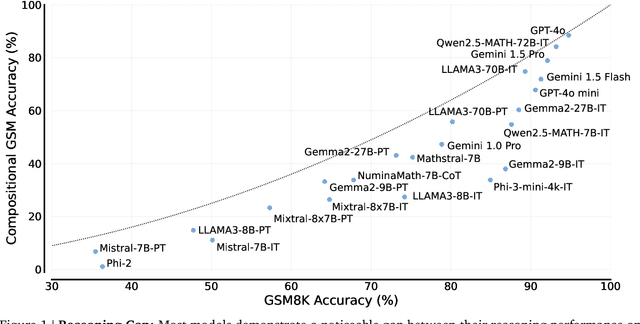
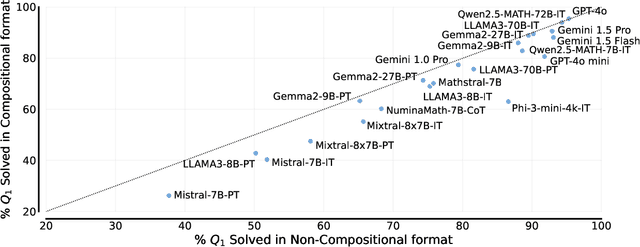
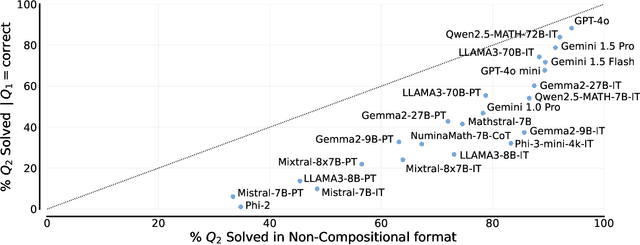
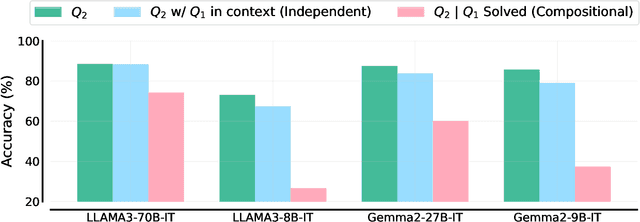
Abstract:We study the depth of grade-school math (GSM) problem-solving capabilities of LLMs. To this end, we evaluate their performance on pairs of existing math word problems together so that the answer to the second problem depends on correctly answering the first problem. Our findings reveal a significant reasoning gap in most LLMs, that is performance difference between solving the compositional pairs and solving each question independently. This gap is more pronounced in smaller, more cost-efficient, and math-specialized models. Moreover, instruction-tuning recipes and code generation have varying effects across LLM sizes, while finetuning on GSM can lead to task overfitting. Our analysis indicates that large reasoning gaps are not because of test-set leakage, but due to distraction from additional context and poor second-hop reasoning. Overall, LLMs exhibit systematic differences in their reasoning abilities, despite what their performance on standard benchmarks indicates.
AndroidWorld: A Dynamic Benchmarking Environment for Autonomous Agents
May 23, 2024



Abstract:Autonomous agents that execute human tasks by controlling computers can enhance human productivity and application accessibility. Yet, progress in this field will be driven by realistic and reproducible benchmarks. We present AndroidWorld, a fully functioning Android environment that provides reward signals for 116 programmatic task workflows across 20 real world Android applications. Unlike existing interactive environments, which provide a static test set, AndroidWorld dynamically constructs tasks that are parameterized and expressed in natural language in unlimited ways, thus enabling testing on a much larger and realistic suite of tasks. Reward signals are derived from the computer's system state, making them durable across task variations and extensible across different apps. To demonstrate AndroidWorld's benefits and mode of operation, we introduce a new computer control agent, M3A. M3A can complete 30.6% of the AndroidWorld's tasks, leaving ample room for future work. Furthermore, we adapt a popular desktop web agent to work on Android, which we find to be less effective on mobile, suggesting future research is needed to achieve universal, cross-domain agents. Finally, we conduct a robustness analysis by testing M3A against a range of task variations on a representative subset of tasks, demonstrating that variations in task parameters can significantly alter the complexity of a task and therefore an agent's performance, highlighting the importance of testing agents under diverse conditions. AndroidWorld and the experiments in this paper are available at https://github.com/google-research/android_world.
Gemini 1.5: Unlocking multimodal understanding across millions of tokens of context
Mar 08, 2024Abstract:In this report, we present the latest model of the Gemini family, Gemini 1.5 Pro, a highly compute-efficient multimodal mixture-of-experts model capable of recalling and reasoning over fine-grained information from millions of tokens of context, including multiple long documents and hours of video and audio. Gemini 1.5 Pro achieves near-perfect recall on long-context retrieval tasks across modalities, improves the state-of-the-art in long-document QA, long-video QA and long-context ASR, and matches or surpasses Gemini 1.0 Ultra's state-of-the-art performance across a broad set of benchmarks. Studying the limits of Gemini 1.5 Pro's long-context ability, we find continued improvement in next-token prediction and near-perfect retrieval (>99%) up to at least 10M tokens, a generational leap over existing models such as Claude 2.1 (200k) and GPT-4 Turbo (128k). Finally, we highlight surprising new capabilities of large language models at the frontier; when given a grammar manual for Kalamang, a language with fewer than 200 speakers worldwide, the model learns to translate English to Kalamang at a similar level to a person who learned from the same content.
Gemini: A Family of Highly Capable Multimodal Models
Dec 19, 2023Abstract:This report introduces a new family of multimodal models, Gemini, that exhibit remarkable capabilities across image, audio, video, and text understanding. The Gemini family consists of Ultra, Pro, and Nano sizes, suitable for applications ranging from complex reasoning tasks to on-device memory-constrained use-cases. Evaluation on a broad range of benchmarks shows that our most-capable Gemini Ultra model advances the state of the art in 30 of 32 of these benchmarks - notably being the first model to achieve human-expert performance on the well-studied exam benchmark MMLU, and improving the state of the art in every one of the 20 multimodal benchmarks we examined. We believe that the new capabilities of Gemini models in cross-modal reasoning and language understanding will enable a wide variety of use cases and we discuss our approach toward deploying them responsibly to users.
Finding Increasingly Large Extremal Graphs with AlphaZero and Tabu Search
Nov 06, 2023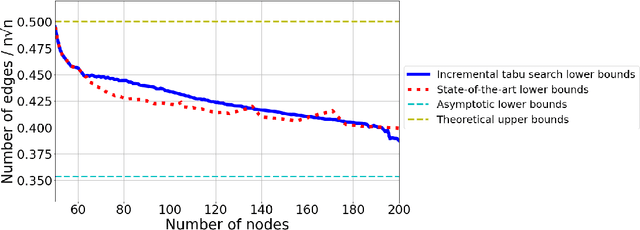
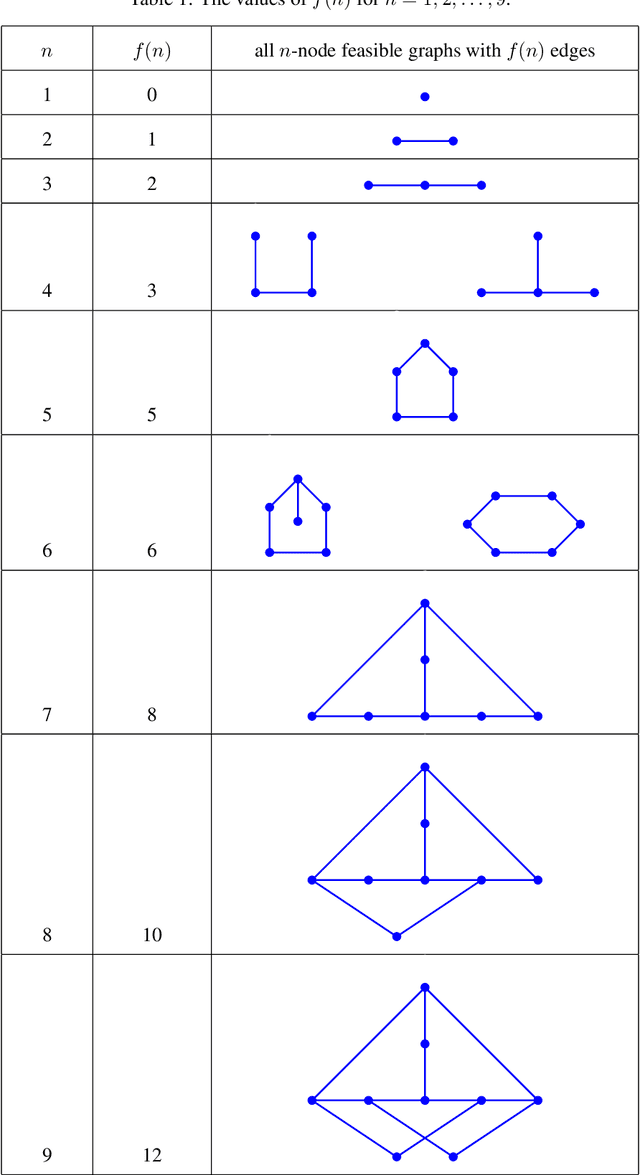
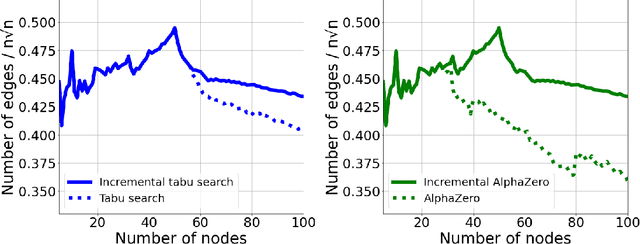
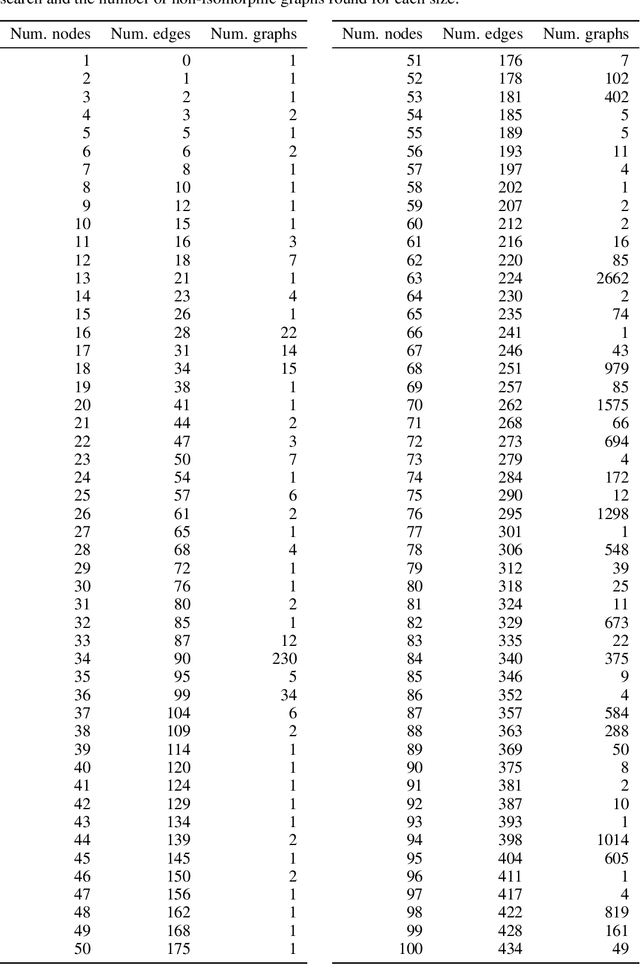
Abstract:This work studies a central extremal graph theory problem inspired by a 1975 conjecture of Erd\H{o}s, which aims to find graphs with a given size (number of nodes) that maximize the number of edges without having 3- or 4-cycles. We formulate this problem as a sequential decision-making problem and compare AlphaZero, a neural network-guided tree search, with tabu search, a heuristic local search method. Using either method, by introducing a curriculum -- jump-starting the search for larger graphs using good graphs found at smaller sizes -- we improve the state-of-the-art lower bounds for several sizes. We also propose a flexible graph-generation environment and a permutation-invariant network architecture for learning to search in the space of graphs.
AlphaStar Unplugged: Large-Scale Offline Reinforcement Learning
Aug 07, 2023



Abstract:StarCraft II is one of the most challenging simulated reinforcement learning environments; it is partially observable, stochastic, multi-agent, and mastering StarCraft II requires strategic planning over long time horizons with real-time low-level execution. It also has an active professional competitive scene. StarCraft II is uniquely suited for advancing offline RL algorithms, both because of its challenging nature and because Blizzard has released a massive dataset of millions of StarCraft II games played by human players. This paper leverages that and establishes a benchmark, called AlphaStar Unplugged, introducing unprecedented challenges for offline reinforcement learning. We define a dataset (a subset of Blizzard's release), tools standardizing an API for machine learning methods, and an evaluation protocol. We also present baseline agents, including behavior cloning, offline variants of actor-critic and MuZero. We improve the state of the art of agents using only offline data, and we achieve 90% win rate against previously published AlphaStar behavior cloning agent.
Learning how to Interact with a Complex Interface using Hierarchical Reinforcement Learning
Apr 21, 2022

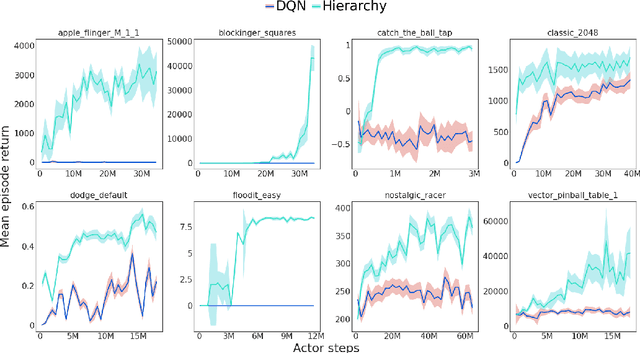

Abstract:Hierarchical Reinforcement Learning (HRL) allows interactive agents to decompose complex problems into a hierarchy of sub-tasks. Higher-level tasks can invoke the solutions of lower-level tasks as if they were primitive actions. In this work, we study the utility of hierarchical decompositions for learning an appropriate way to interact with a complex interface. Specifically, we train HRL agents that can interface with applications in a simulated Android device. We introduce a Hierarchical Distributed Deep Reinforcement Learning architecture that learns (1) subtasks corresponding to simple finger gestures, and (2) how to combine these gestures to solve several Android tasks. Our approach relies on goal conditioning and can be used more generally to convert any base RL agent into an HRL agent. We use the AndroidEnv environment to evaluate our approach. For the experiments, the HRL agent uses a distributed version of the popular DQN algorithm to train different components of the hierarchy. While the native action space is completely intractable for simple DQN agents, our architecture can be used to establish an effective way to interact with different tasks, significantly improving the performance of the same DQN agent over different levels of abstraction.
Scaling Language Models: Methods, Analysis & Insights from Training Gopher
Dec 08, 2021


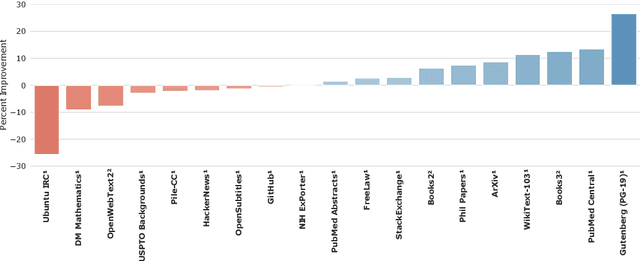
Abstract:Language modelling provides a step towards intelligent communication systems by harnessing large repositories of written human knowledge to better predict and understand the world. In this paper, we present an analysis of Transformer-based language model performance across a wide range of model scales -- from models with tens of millions of parameters up to a 280 billion parameter model called Gopher. These models are evaluated on 152 diverse tasks, achieving state-of-the-art performance across the majority. Gains from scale are largest in areas such as reading comprehension, fact-checking, and the identification of toxic language, but logical and mathematical reasoning see less benefit. We provide a holistic analysis of the training dataset and model's behaviour, covering the intersection of model scale with bias and toxicity. Finally we discuss the application of language models to AI safety and the mitigation of downstream harms.
RLDS: an Ecosystem to Generate, Share and Use Datasets in Reinforcement Learning
Nov 04, 2021



Abstract:We introduce RLDS (Reinforcement Learning Datasets), an ecosystem for recording, replaying, manipulating, annotating and sharing data in the context of Sequential Decision Making (SDM) including Reinforcement Learning (RL), Learning from Demonstrations, Offline RL or Imitation Learning. RLDS enables not only reproducibility of existing research and easy generation of new datasets, but also accelerates novel research. By providing a standard and lossless format of datasets it enables to quickly test new algorithms on a wider range of tasks. The RLDS ecosystem makes it easy to share datasets without any loss of information and to be agnostic to the underlying original format when applying various data processing pipelines to large collections of datasets. Besides, RLDS provides tools for collecting data generated by either synthetic agents or humans, as well as for inspecting and manipulating the collected data. Ultimately, integration with TFDS facilitates the sharing of RL datasets with the research community.
The Option Keyboard: Combining Skills in Reinforcement Learning
Jun 24, 2021

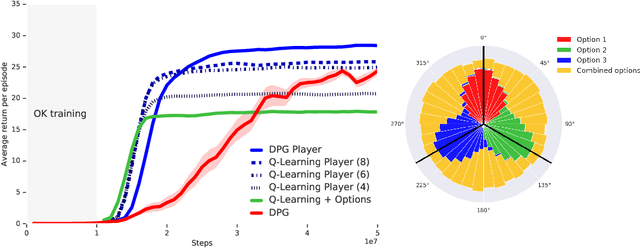

Abstract:The ability to combine known skills to create new ones may be crucial in the solution of complex reinforcement learning problems that unfold over extended periods. We argue that a robust way of combining skills is to define and manipulate them in the space of pseudo-rewards (or "cumulants"). Based on this premise, we propose a framework for combining skills using the formalism of options. We show that every deterministic option can be unambiguously represented as a cumulant defined in an extended domain. Building on this insight and on previous results on transfer learning, we show how to approximate options whose cumulants are linear combinations of the cumulants of known options. This means that, once we have learned options associated with a set of cumulants, we can instantaneously synthesise options induced by any linear combination of them, without any learning involved. We describe how this framework provides a hierarchical interface to the environment whose abstract actions correspond to combinations of basic skills. We demonstrate the practical benefits of our approach in a resource management problem and a navigation task involving a quadrupedal simulated robot.
 Add to Chrome
Add to Chrome Add to Firefox
Add to Firefox Add to Edge
Add to Edge